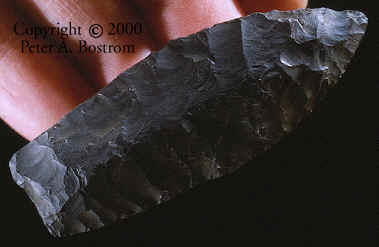|
CAST
#P-15
MESA SITE
PROJECTILE POINT
CAST
(NUMBER kir-102-92-01)
ARCTIC CIRCLE
BUREAU OF LAND
MANAGEMENT

CAST
#P-15
CLICK ON
PICTURE FOR VIEW OF ORIGINAL POINT
MESA SITE SPEAR POINT
CAST
MESA SITE
NORTHERN ALASKA ABOVE THE ARCTIC CIRCLE
This projectile point was most probably hafted onto the end of a
spear. This may have been done indirectly by a short foreshaft
that would in turn have been attached to the spear shaft. It may
have been used to kill large but now extinct animals like a
giant bison or mammoth. This spear point, although complete and
unbroken, has been resharpened. This point measures 2
11/16 inches long.
The Mesa site was discovered in 1978 by Bureau of
Land Management archaeologist Michael Kunz in the northern foothills of Alaska's
Brooks Range above the Arctic Circle. The site was tested in 1979 and 1980. Full
scale summer excavations began in 1991 and continued through
1999. Several years of excavations eventually
produced 51 carbon dates that range from 11,700 to 9,700 years before present.
The best estimated core record of time for the Paleo feature of
this site seems to be somewhere between 10,400 and 9,800 years
ago.
The Mesa site is recognized as the first well-documented Paleo-Indian site to be
found in the North American Arctic.
The Mesa site
is located on a high plateau approximately 200 feet above the rolling Arctic
tundra. It was periodically used as a hunting lookout that provided a 360 degree
view of the treeless plains below for more than 60 square miles. These early
people were hunting big game animals such as caribou, musk oxen, extinct bison
and mammoths. This
lookout provided them with a convenient way to locate animals in the area.
The Mesa site produced a classic Early-Paleo stone tool
assemblage. Leading North American Paleo-Indian archaeologists Dr. George
Frison, Dr. C. Vance Haynes and Dr. Dennis Stanford have visited the site and
studied the artifacts and have concluded that the Mesa tool assemblage is
typically Paleo-Indian. Also, other archaeologists have studied the tool assemblage
and have reach the same conclusion. This site produced gravers of a type that
have been found in Clovis tool assemblages from coast to coast in the
United States. End-scrapers with and without spurs were also found. End-scrapers
or so-called thumbnail scrapers are found in tool kits on the majority of very
early Stone Age sites in North America.
The more than one hundred projectile points that were found on the Mesa site are very
similar to Agate Basin points, although they seem to average slightly smaller. This
may be a factor directly caused by chert availability in the area. These
projectile points were most probably hafted on spears and thrown with an atlatl
or throwing stick. They may have even been hafted onto short fore shafts that
could have quickly and easily replaced a broken point on a larger spear shaft.
The "Mesa points" are lanceolate in outline and have heavily ground or
smoothed basal edges where they were hafted to a spear. These points were
resharpened and repointed uniformly by pressure flaking without beveling like
some later types of spear points.
Only two later period features were found on the
Mesa site. One is in locality A where a late northern Archaic
micro-blade feature was found that dates to approximately 3500
years ago. Most of the artifacts found there were 120
micro-blades. Another item, a 45-70 cartridge, was also found on
the Mesa site. This fairly recent artifact probably indicates
that sometime between 1885-1910 an Eskimo had climbed to the
site and fired at an animal on the Arctic tundra below.
The Mesa site was an important discovery. It has contributed new
theories and insights into how these early people lived and were colonizing the
New World.
|